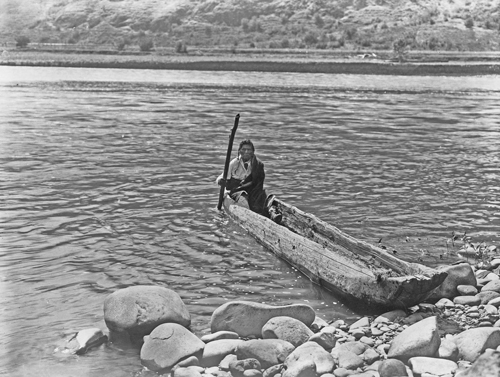Nez Percé canoe

Photo by Edward S. Curtis c. December 8, 1910.
Originally published in: The North American Indian, 8:46. From the Library of Congress: https://lccn.loc.gov/2002722464 accessed on 2017 Dec 10.
Ed. note: The canoe pictured here was likely not the canoe they left behind.
In 1805, the Lewis and Clark expedition built five canoes while camped at Canoe Camp near the town of Orofino, Idaho. From September 26 to October 7, they built four large canoes and a smaller pilot canoe. None of the journalists recorded any dimensions, so we will never know the actual sizes of these canoes. We do know that the five canoes were capable of carrying 35 people, all of their supplies, the large dog "Seaman," and sometimes several dogs they purchased for food.
On the return trip in 1806, they left their last canoes just above the Celilo Falls on the Columbia River. From this point to where they had left their canoes near the headwaters of the Missouri River, they traveled by land. They crossed the Snake River below Clarkston, Washington, and the Clearwater River near Lenore, Idaho, and Kamiah, Idaho, using Indian canoes.
On May 14, they crossed the Clearwater River near the grain elevators at Kamiah, Idaho. After crossing the river, they proceeded to move their baggage approximately ½ mile downstream to a place they had previously selected for a permanent camp, to wait for the snow to melt enough for them to cross the mountains.
On this day, Lewis wrote:
This is a very eligible spot for defence it had been an ancient habitation of the indians; was sunk about 4 feet in the ground and raised arround its outer edge about three ½ feet with a good wall of earth. The whole was a circle of about 30 feet in diameter. Arround this we formed our tents of sticks and grass facing outwards and deposited our baggage within the sunken space under a shelter which we constructed for the purpose. Our situation was within 40 paces of the River in an extensive level bottom thinly timbered with long leafed pine. Here we are in the vicinity of the best hunting grounds from the indian information, are convenient to the salmon which we expect daily and have excellent pasture for our horses.
The salmon did not arrive during their stay at Camp Chopunnish, and by May 21, Lewis wrote:
we set five men at work to make a canoe for the purpose of fishing and crossing the river. The Indians have already promised us a horse for this canoe when we have no longer any use for her.
On May 22, Lewis sent Sergt. Pryor down to the entrance of Collins Creek (present Lolo Creek) to examine the country and to look for a good place to camp. They had determined to remove their camp below that creek if it remained high, as soon as they completed their canoe. They wanted to hunt near the Quamash Flats (present Weippe, Idaho). Sergt. Pryor returned late in the afternoon and said he had been down about 8 miles, and that the cliffs set in so abruptly that he could go no further.
On May 22, Ordway wrote, "in the evening we made a fire on the canoe to bum it out". On May 26, Lewis wrote, "in the afternoon we finished the canoe and put her in the water. she appears to answer very well and will carry about 12 persons." None of the journalists recorded any dimensions of this canoe.
On May 30, Lewis wrote:
Shannon and Collins were permitted to pass the river to trade with the natives and lay in a store of roots and bread for themselves with their proportion of the merchandize as the others had done: in landing on the opposite shore the canoe was driven broadside with the full force of a very strong current against some standing trees and instantly filled with water and sunk. Potts an indifferent swimer, it was with much difficulty he made the land. They lost three blankets, a blanket coat and their pittance of merchandize. In our bear state of cloothing this was a serious loss. I sent Sergt. Pryor and a party over with the indian canoe in order to raise and secure ours but the depth of the water and the strength of the current baffled every effort. I fear that we have also lost our canoe which was sunk.
On June 8, Ordway wrote, "a number of the natives joined and got our canoe which was sunk." They left the canoe with the Indians when they left Camp Chopunnish on June 10, 1806. This was the only canoe they left in Idaho.
Information from the Journals of Lewis & Clark Expedition, Gary E. Moulton, Editor, University of Nebraska Press.